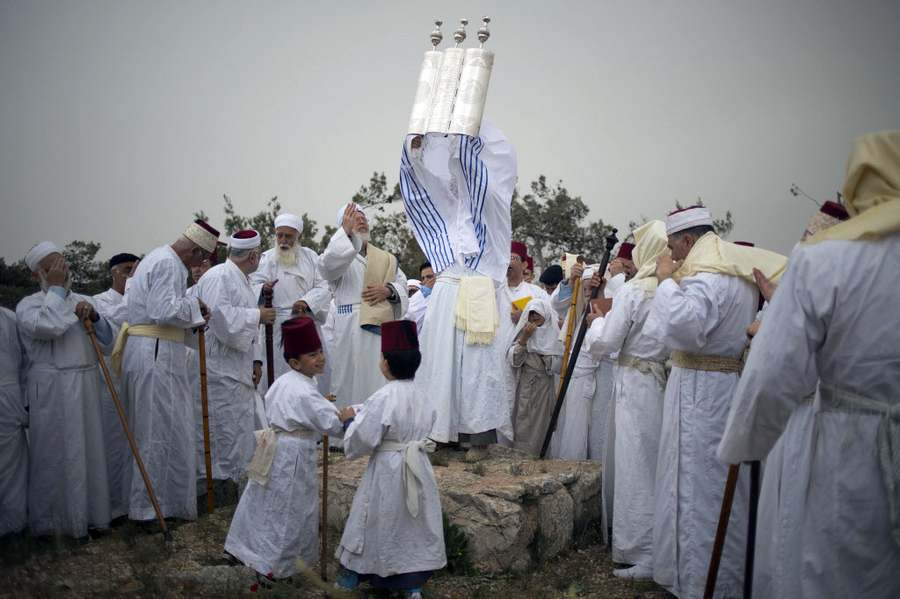In West Bank, good Samaritans seek foreign brides
Loading...
| Kfar Luza, West Bank
On a hilltop in the West Bank, a sea of worshippers clad in white gather for an ancient, unfamiliar Passover ceremony, chanting ritual prayers in Aramaic. In their midst are a smattering of newcomers: a tall blonde woman in a crisp suit and stiletto heels and a blue-eyed young woman who speaks with her animatedly in Russian, rocking her young daughter in a carriage.
Ukrainian-born Tanya Onischenko, the blue-eyed mother, is one of the newest members of the Samaritans, an ancient Israelite sect. Until five years ago, she was unaware they still existed. For millennia, Samaritans only married within their faith, but the limited gene pool has yielded an increasing number of babies born with genetic defects. The shrinking sect has opted to break with tradition and look elsewhere for marriage partners.
The story of how Ms. Onischenko swapped Ukraine for the town of Kfar Luza on Mt. Gerizim sounds like the plot for a romantic comedy: She was working as a matchmaker-translator in her local bridal agency in western Ukraine when Tami Altif walked in. Tall and handsome, he was looking for a “serious” bride. Onischenko showed him photographs and profiles of eligible locals. “But having met me in real life, he didn’t want to look at any photos”, she says, laughing.
Today there are about 10 Ukrainian women in the two surviving Samaritan communities, together totaling fewer than than 800 people. Samaritan men have also married brides from Kazakhstan, Turkey, and Russia. A smattering of Jewish women have converted to the sect. But by far the largest number is from Ukraine, mostly Christians raised in secular communities.
Transplanted to the biblical lands of Judea and Samaria, Ukrainian wives still send money back home to their relatives and talk of tough times back home. But they also emphasize their emotional bond with their Samaritan husbands.
“He didn’t tell me any fairy tales, didn’t boast or exaggerate”, explains Onischenko. “He was simple, he didn’t talk a lot. He didn’t make unrealistic promises. And so I quickly saw that with this person you could go through life.”
Yousef Cohen, a Samaritan priest whose son recently married a Ukrainian, thinks he knows why the match worked out. “Because [Ukrainian women] are lovely, and they are not religious, and it is easy to make them Samaritans,” he says, referring to their secular upbringing in Ukraine.
Arduous preparations
The process to become a Samaritan is long and requires familiarity with the faith, which has some commonalities with Judaism, but also distinct differences.
Onischenko read up on the faith for a year while applying for an Israeli visa. “I asked so many questions from my friends and other women who had already converted, and did lots of reading online," she says.
One Samaritan custom she learned about was the practice of women having to live separately from their husbands during menstruation and for a period of 80 days after giving birth. After learning about the faith, the next step is to live in the community for a trial period of up to one year.
“It’s a serious matter – it’s not like you take off on a whim, and if you don’t like it, you just come back,” says Onischenko.
Tanya and other newcomers also learn the Samaritan way of "balancing" amid the tense politics of the region. Approximately half of the community lives in Holon, Israel, while the Samaritans of Mount Gerizim in the West Bank. The latter carry both Israeli and Palestinian identity cards, allowing them to work in Nablus, which is run by the Palestinian Authority, while getting access to Israeli healthcare.
Bridge building to communities
Some Samaritans work as civil servants and in other professional fields, while others work as traders, leveraging their ability to travel freely within Israel and the West Bank. For foreign brides, local factories can provide jobs while they learn the Hebrew and Arabic that Samaritans speak.
At this year's Passover ceremony at Kfar Luza, the Samaritans' bridge-building approach is reflected in the guest list. Headscarf-wearing Muslim university students from Nablus mingle with a group of born-again American Christians and Orthodox Jews from Jerusalem.
As the sun sets, all gather to watch a ritual that has been practiced in the same spot for over 3,500 years. The priests lead prayers and chants, while two opposing columns of men corral a group of around 50 sheep sent to the slaughter. As the moon rises in the eastern sky, the men take out knives and butcher the sheep as the Passover prayers reach a crescendo.
“We read about this, whilst they do actually do it,” says a Jerusalem resident, as Samaritans – including the foreign-born brides – embrace in celebration of Passover and dab a dot of sheep's blood on their foreheads. Lamb carcasses are skewered and roasted. The feast had begun.







